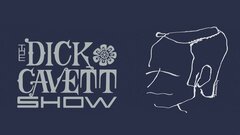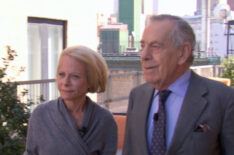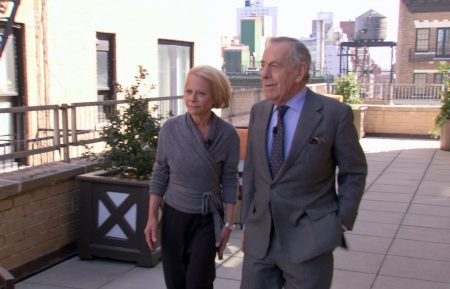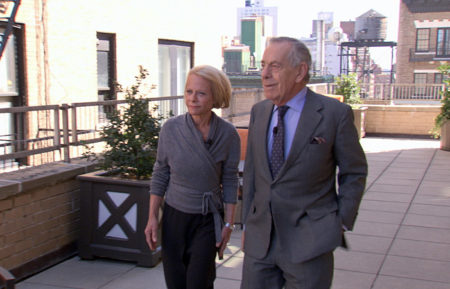Morley Safer

Journalist
Birth Date: November 8, 1931
Death Date: May 19, 2016
Birth Place: Toronto, Ontario, Canada
The son of an Austrian immigrant whose family was lost to the Nazi purges, Canadian-born journalist Morley Safer grew up in the shadow of the Second World War, reading several newspapers a day and listening to radio dispatches from Europe. As a cub reporter for the Canadian Broadcasting System during the Fifties, Safer served his apprenticeship in London, where he would later be posted as a bureau chief for the American network, CBS. Initially uncomfortable with the transition from writing the news to appearing on-camera, Safer distinguished himself during two tours of duty in Vietnam, where his reporting on atrocities committed by U.S. troops changed the national perception of the war in Southeast Asia and drew the ire of then-President Lyndon B. Johnson, who branded Safer anti-American.
In 1970, Safer accepted a correspondent's position on the groundbreaking news magazine program "60 Minutes" (CBS, 1968- ). Safer's probing but anti-sensational approach to news-gathering made him an audience favorite, a trusted voice, and an avuncular tonic to the show's muckraking star, Mike Wallace, with whom Safer frequently found himself in contretemps.
A multiple Emmy Award winner and recipient of a host of awards for journalistic excellence, Morley Safer's more than 50-year career stamped him as an international icon of old school journalism, a television news pioneer and one of the last links to the golden age of news reporting, staying on staff at "60 Minutes" until the week before his death from pneumonia at the age of 84 on May 19, 2016.
Morley Safer was born on Nov. 8, 1931, in Toronto, Ontario in Canada. He was the third and youngest child of Max Safer, an Austrian immigrant who owned a small upholstering business in Toronto, and the former Anna Cohen, who had come to Canada from her native London.
A gregarious, outgoing youth who excelled at football, hockey and baseball, Safer showed an early interest in painting but ultimately pointed himself towards the less sedentary occupation of journalist. Raised during World War II, Safer had read voraciously even as a child, both news items in The Toronto Star and the dispatches of Ernest Hemingway from the Spanish Civil War and the Second World War.
After graduating from high school, Safer spent a few dispiriting weeks at the University of Western Ontario before dropping out and making a go of a life as a newsman. After early discouragement, Safer won a spot on the staff of The Woodstock Sentinel Review, a community newspaper that published six times a week and paid him a weekly salary of $25 dollars.
Safer was able to parlay his experience as a reporter for the small town paper into a staff position with the larger London Free Press in the metropolitan hub of London, Ontario. From the inauspicious start of composing obituaries, Safer worked his way up to the task of general reporting and also served as a rewrite man, putting together news stories from the field notes of other reporters.
Eager to get out of Canada and see the world, Safer applied for the Kemsley Fellowship, an endowment that would have sent him to England to work for Kemsley Newspapers. Although he was not awarded the fellowship, Safer did receive the offer of a job, so long as he could pay his own way to the United Kingdom.
In England in the early 1950s, Safer segued quickly from a menial job at The Oxford Mail (where he was once upbraided for not wearing a necktie while stopping by the office on his day off) to overnight work at the central desk for Reuters in London, at a weekly salary of £19. By the winter of 1955, Safer had had his fill of the life of an itinerant journalist and began applying for jobs back in Canada.
An encouraging response was returned from The Toronto Telegraph but the job would not begin until after the first of the New Year. Needing some stop-gap income, Safer accepted what was to be a temporary job with the Canadian Broadcasting Company. Broadcast news was still many years away from attaining currency within the field of journalism, but Safer found himself excited by the challenges presented by the medium and invigorated by being part of the process of making up its rules.
When the New Year arrived, Safer stayed on at CBC. When his new employers created the "CBC News Magazine," a weekly news and information program that aired on Sunday nights, Safer was asked to serve as editor, fulfilling the job description of a producer. Safer had gotten early on-camera experience as a foreign correspondent covering the Suez crisis in Israel and in Egypt in 1956 but remained more comfortable off-camera than on at this point in his career.
Safer did eighty percent of the writing for the news magazine and all of the editing until a falling out with CBC prompted his resignation. After a brief return to London, where he wrote overnight radio copy for the BBC, Safer accepted a job in Canada with the news division of the independent television station CFTO in Toronto. Safer acted as editor-in-chief of the evening news for only six months before his former bosses at CBC invited him return as a producer and correspondent in London.
The experience allowed Safer to travel throughout Europe and to Africa in the pursuit of news stories. He ultimately ascended to the position of bureau chief and was serving in that capacity when he was scouted by the Columbia Broadcasting Company in America.
Safer's first dateline for CBS was in Cypress, where he had previously filed dispatches as a correspondent for CBC. In 1964, he became the CBS London correspondent, taking over the desk vacated by veteran newsman Edward R. Murrow in the network's Hallam Street office. By 1965, Safer was in Saigon to establish the CBS news bureau in Vietnam.
His report of a punitive "Zippo raid" by U.S. troops on the village of Cam Ne drew fire from President Lyndon B. Johnson, who accused the reporter not only of being recklessly anti-American but of being a possible Communist agitator. Between 1967 and 1970, Safer served as CBS bureau chief, based in London. In 1970, he returned to the United States to replace Harry Reasoner as one of the hosts of the primetime news magazine "60 Minutes" (CBS, 1968- ).
As the avuncular Reasoner had been, Safer was offered to viewers in sharp contrast to the confrontational style of co-host Mike Wallace, whose specialty was the "gotcha" interview of surprising interview subjects with uncomfortable questions. Though Safer and Wallace remained friends through their long professional relationship, the pair made no secret of their frequent quarrels.
During his first year as a "60 Minutes" correspondent, Safer filed stories from around the globe on the escalating Vietnam War, on the troubles between Protestants and Catholics in Northern Ireland, on unrest in Nigeria and the Middle East, and on American draft dodgers, but his style would evolve over time, softening to embrace more human interest stories.
Safer's true métier was the congenial celebrity interview, along with humor-laced lifestyle pieces focused on curious pastimes, scientific advancements and even his own interest in fine art. In 1983, Safer's profile of Lenell Geter, a Texas engineer wrongly convicted of armed robbery, resulted in the overturning of Gerter's life sentence and his eventual release from prison.
In 2001, he profiled a controversial experimental school for homeless children. In 2009, Safer was granted a rare interview with reclusive Vogue Editor-in-chief Anna Wintour. A multiple Emmy Award, Peabody Award and Overseas Press Club Award winner, Safer was also the recipient of numerous awards given for excellence in broadcast journalism.
In 1995, he was named a Chévalier dans l'Ordre des Arts et des Lettres by the French government. Safer remained a fixture on "60 Minutes" until he announced his retirement in May 2016. Only days after his farewell show, Morley Safer died of pneumonia on May 19, 2016. He was 84.
Credits

True Crime Files

House of CardsStream

60 Minutes Presents: Three Remarkable Women

The Injustice Files

Sins & Secrets

60 Minutes on ID

Chasing Justice with Dan Abrams

Breaking the News

Exodus 1947

Exodus 1947
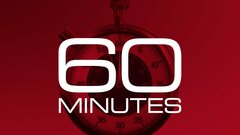
60 MinutesStream
